Abstract
Modern sports training requires increased attention to all components depending on the specific structure of each branch or practiced sports events. However, in most cases, physical training is recognized as a fundamental factor in the preparation process of athletes, as only optimal development of general and specific driving ability can bring success in sports competitions. Based on the available information analysis of specialists, it can be said that the game of basketball and teams preparation are done globally, without taking into account the individual work stations. Each task in this game is in addition to a general orientation training and some specific features, which in turn require specific training methods. That is why we chose the present theme in an attempt to prove that the differential treatment of specific physical preparation by biological reasons, depending on the position held in the game (for junior basketball players of 17-18 years old, in our case), players could increasing efficiency and therefore better results being obtained in contests and competitions, which give our study regarding current concerns and trying their implementation. We use our research about the main topic, a questionnaire type dark character, applied for specialized teachers and coaches in basketball. Questionnaire’s items have lied to obtain information about their views on training objectives for junior teams aged 17-18 years, also the place and role of physical training appropriated to the age mentioned.
Keywords: Sociological researchphysical trainingbasketballjunior
Introduction
Diversity and complexity of the manifestation in effort of technical processes and achievement of their actions tactical collective and individual specific phases of the game, we suppose, in the perspective of practicing basketball game, a longer period of the time dedicated to physical development and functional adaptation at some different stimulus in the period of beginning at an early age based-forms, principles, methods and their own means regarding organizing and training (in our case, for junior basketball players, aged 17-18 years).
Regarding above mentioned issues, we believe that, in large part, our research will improve the system of training practiced in Romanian basketball and we purpose reconsiderations for theoretical concepts of playing this game, training and competition, and the implementation of them still for junior age, generally (Predescu Ghiţescu, 2001).
Problem Statement
Experts of this domain believe that the preparation process must be designed to meet the competitive game model determined by the emulation and performance targets. To achieve such a finality we consider the objectives of training content to be appropriated for each component of training process, their importance being accorded to the time and steps established by the annually training plan with number of games to be verified its level, also number of games with official character, also methods and procedures used for this purpose (Colibaba-Evuleț & Bota, 1998).
Using local knowledge and role of physical training in specific sports training like basketball for junior players, we analyze its components that can be achieved in terms of nowadays theoretical and methodological concepts.
In this regard, it is to be considered that both capacities - conditional and the coordinative ones (with their physical attributes and derivatives) - are necessary to be practiced in the game of basketball in present degrees of determination and different development, which require an investigation in detailed levels of the manifestation of its successful approach for physical training (Ghițescu, 2007)
Research Questions
In our research we started from the following question: can we determine by a sociological survey of opinions including specialists who work at this age level sharing and physical training content level for juniors players of basketball?
Purpose of the Study
The purpose of this paper is mainly due to obtain information on the views of teachers and coaches specializing in basketball, by performing specific activities for juniors I, on training objectives for junior teams aged 17-18, and the place and role preparation age-ranged corresponding for physical reasons.
Research Methods
In the proposed study we used the following research methods: observation pedagogical, scientific and methodical documentation specialist, talk and survey-based questionnaire method statistical and mathematical data processing and graphical representation method (Dragnea, 1984).
Survey method in physical education and sport aims to investigate attitudes, opinions, reasons, subjective states of cognitive and affective sphere (Epuran & Marolicaru, 2002).
Regarding the purpose of the present method, it consisted of discussions with both teachers and coaches and athletes included in the research on the objectives of investigations, methods and means to come to be used. We also use in our research about the topic a questionnaire with 15 questions (items) with openness applied to 35 teachers and basketball coaches specializing in carrying out specific activities for juniors level I. Items of followed questionnaire was made to obtain information on their views regarding training objectives for junior teams aged 17-18 years, and the place and role of physical training appropriate for noted age range. The survey was conducted from September 15 to October 30, 2013.
Findings
The purpose of expected results from the 35 subjects of this study, with specific methods used in scientific research in physical education and sport, include questionnaire-based survey. The results were processed from statistical and mathematical point of view.
By analyzing and processing the responses to item 1 of the survey questionnaire, which refers to the readiness of basketball for junior (17-18 years old), 5 respondents said that it is very good, ie 14.28%; 22 of the respondents (62.85%) of the opinion that it is good, while 4 (11.42%) consider medium, and 3 (8.57%) and 1 (2.88%) opted for low and very low variations (fig. 1).
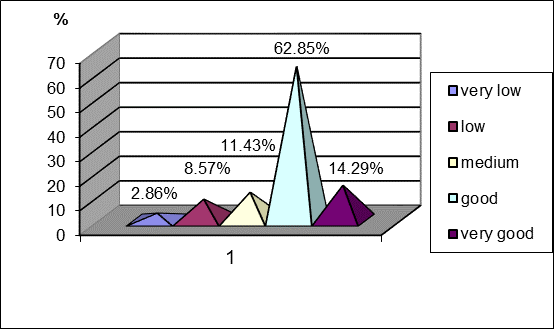
Regarding responses to item 2 on the crucial role it plays makers sports training in the game of basketball, with performance, according to the respondents, they should be: a majority of them (11 - 31.43%) opting for physical training; most (12 to 34.29%) for the technique; 9 (25.71%) consider important tactical preparation, and 3 (8.57%) chose the one psychological (fig. 2).
It appears the orientation favorite teachers and coaches questioned by physical training, which shows attention in the education of conditional and coordinative capacity, in fact, it noted the studies. Also, it can be stated that the factor concerned - physical training - plays an important role in the complete preparation of sportsmen basketball, something reflected in our research, but we believe that, from this point of view, it should be reflected in general sports training calendar, with values as close to those of technical and tactical training.
However, it appears that the largest number of respondents (12 - 34.29%) ranked first, with a major role in obtaining performance in the game of basketball, technical training.
Those considerations demonstrate, once again, the veracity of main studies, namely the domain of experts focused their attention on conditional and coordinative capacity in close correlation with improvement of techniques and elements specific to this age for basketball. Tactical preparation holds a large proportion (9 - 25.71%), in the answer options of the participants to the questionnaire and differentiating comparative share of tactical training, being noticeable that the two components of sports training are still inseparable.
Although psychological preparation plays an important role in achieving sport performance, which is very atested by the literature and the practice field, those who opted for it are quite a few (3 to 8.57%). In this perspective, by comparing physical training and technical-tactical one, we believe that the latter ones are a little bigger, for the mentioned age of juniors I basketball players, based on technical training and tactical one is to be considered to be already approached, which implies that this echelon physical training should prevail, given be the requirements of modern sports training and competitions (speed of action, throws, quick changes of rithm, etc.).
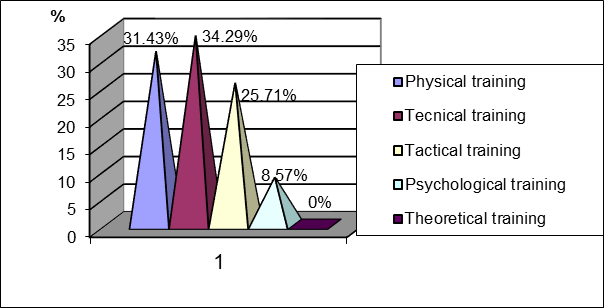
As regards about optimal age range that can pay more attention to general and specific physical preparation (item 3), the percentage of responses was: 11.43% for 11 to 12 years; 20% for 13-14 years, and the majority, 60%, believes the optimal age for general and specific physical preparation 15-16 years and the remaining 8.57% opted for 17-18 (fig. 3).
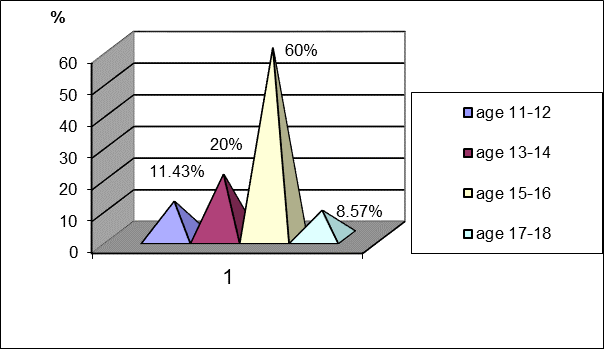
To determine which component of sports training, it is to be taken into attention the preparation of junior I players (item 4) in order to obtain good results, responses was as follows: 11 respondents (31.43%) opted for physical training, 12 (34.29%), they considering it important technical training, while 9 (25.71%) say that tactical preparation is important, and two (5.71%) and 1 (2.86%) opted for psychological preparation and theoretical ones (fig. 4). This reveals a similarity of responses to the items 2 and 4, reiterating the necessity of the importance of biger physical training.
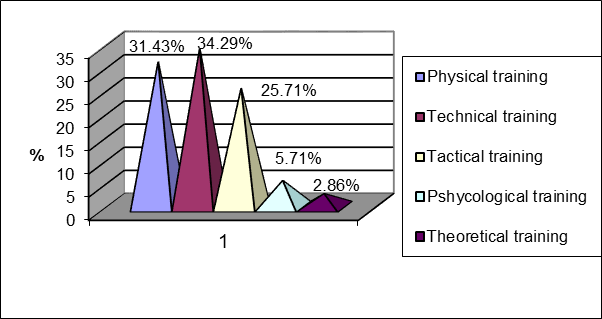
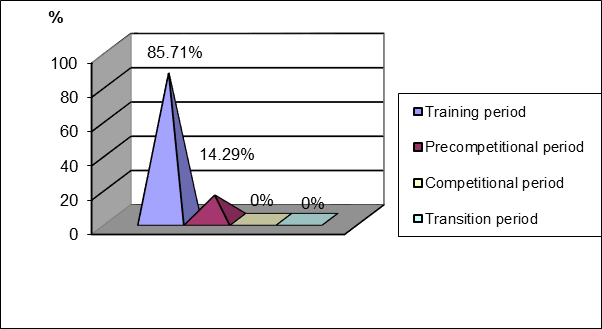
Regarding the period of training to be given a larger share of basketball - physical training specific for juniors (item 5), 30 (85.71%) of respondents were agreed that this is the preparatory period, and the remaining 5 (14.29%) indicated during pre-competitive one (fig. 5).
For the item 6, on the role of specific physical training in preparation for junior basketball overall, 16 respondents (45.71%) considered it very important; 15 (42.86%) - important, while four (11.43%) believed that physical training has a specific importance in the preparation of the general average of these players (fig. 6).
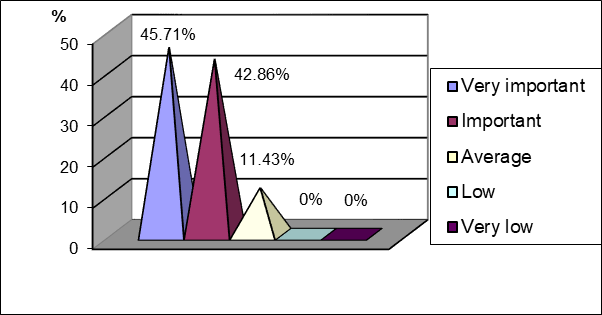
We present below specialists opinion regarding sport exercises, they considering them as being important in preparing specific physical level of junior basketball players I. From this point of view, most of the 18 respondents, representing 51.43% indicated means development of specific resistance, 10 - 28.57%, indicated the means for developing specific speed and 8, or 20% opted for means of developing the specific force (fig. 7).
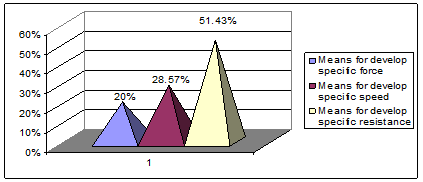
About the need for a systematization unit of specific physical preparation of basketball junior players in our country, the answers was as follows: 20 respondents (57.14%) consider it desirable, 10 (28.57%) do not believe that it is absolutely necessary, and the remaining 5 (14.29%) say that it is not necessary (fig. 8).
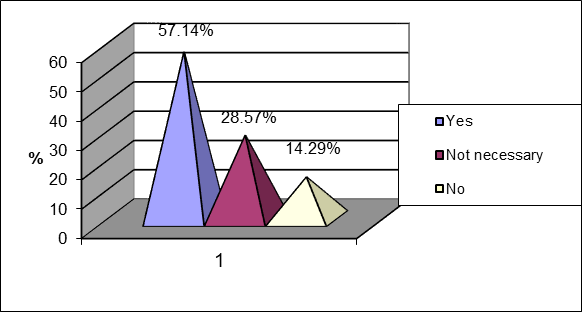
Conclusion
After analysis of the answers to the questions in the questionnaire teachers and coaches working with junior I, we concluded that the level of preparedness of basketball players aged 17-18 years is relatively good. All coaches recognize that specific physical preparation of basketball has big gaps in 17-18 years, it being the technical and tactical support for training, and 57.14% consider a uniform system of training as necessary.
In regard to the specific physical preparation of basketball junior I that the 35 respondents operate, only 11.43% consider it very good, while the vast majority of 42.86% consider it as an average, and 5.71% place it on a low level of importance.
Conditional related capabilities which must be given special attention when preparing basketball 17-18 years are corresponding to following results: 42.86% make the first resistance and equal weight, of 10 responses, 28.57% was attributed to speed or force. Hence the close correlation between the length of a basketball official matches, efficiency and execution phases of game technical, requiring a higher level of expression of specific resistance which means an increased adaptation to high intensity efforts. At the same time, it is obvious to be noted that the experts of the interviewees agree that although the speed capability in all its forms, being hardly amenable to this age group, it remaining in the spotlight, given being the dynamics of basketball game. Regarding the ability of power in sport actions, answers recorded show that it is going to enter into a new phase of achieve to train of body of athletes for a final stage of development, and the combination of strength and speed (expansion) is essential in completing phases of attack (shots, offensive rebounds) and defense (defensive rebounds, blocks, etc.), but acting with caution.
In the same time, we noticed that the vast majority of teachers and coaches questioned think that the game of basketball is one dynamic and complex, which has determined 71.43% of them recognize the crucial and complex role of the motric qualities, namely that speed-force regime in resistance - handiness skill.
Acknowledgments
All this material is the only result of author’s research.
References
- Colibaba-Evuleţ, D. Bota, I. (1998). Jocuri sportive. Teorie şi metodică. București: Editura Aldin.
- Dragnea, A. (1984). Măsurarea şi evaluarea în educaţie fizică şi sport. București: Editura Sport-Turism.
- Epuran, M., Marolicaru, M. (2002). Metodologia cercetării activităţilor corporale. Cluj Napoca: Risoprint.
- Ghiţescu, I. (2007). Aspecte teoretice si conceptuale ale pregatirii juniorilor in baschet. București: Editura Matrixrom.
- Predescu, T. Ghiţescu, G. (2001). Baschet. Pregătirea echipelor de performanţă. Bucureşti: Editura SEMNE.
Copyright information

This work is licensed under a Creative Commons Attribution-NonCommercial-NoDerivatives 4.0 International License.
About this article
Publication Date
30 July 2017
Article Doi
eBook ISBN
978-1-80296-026-6
Publisher
Future Academy
Volume
27
Print ISBN (optional)
-
Edition Number
1st Edition
Pages
1-893
Subjects
Teacher training, teaching, teaching skills, teaching techniques,moral purpose of education, social purpose of education, counselling psychology
Cite this article as:
Savu, C. F. (2017). Sociological Research Regarding Physical Training For Junior Basketball. In A. Sandu, T. Ciulei, & A. Frunza (Eds.), Multidimensional Education and Professional Development: Ethical Values, vol 27. European Proceedings of Social and Behavioural Sciences (pp. 714-721). Future Academy. https://doi.org/10.15405/epsbs.2017.07.03.85

